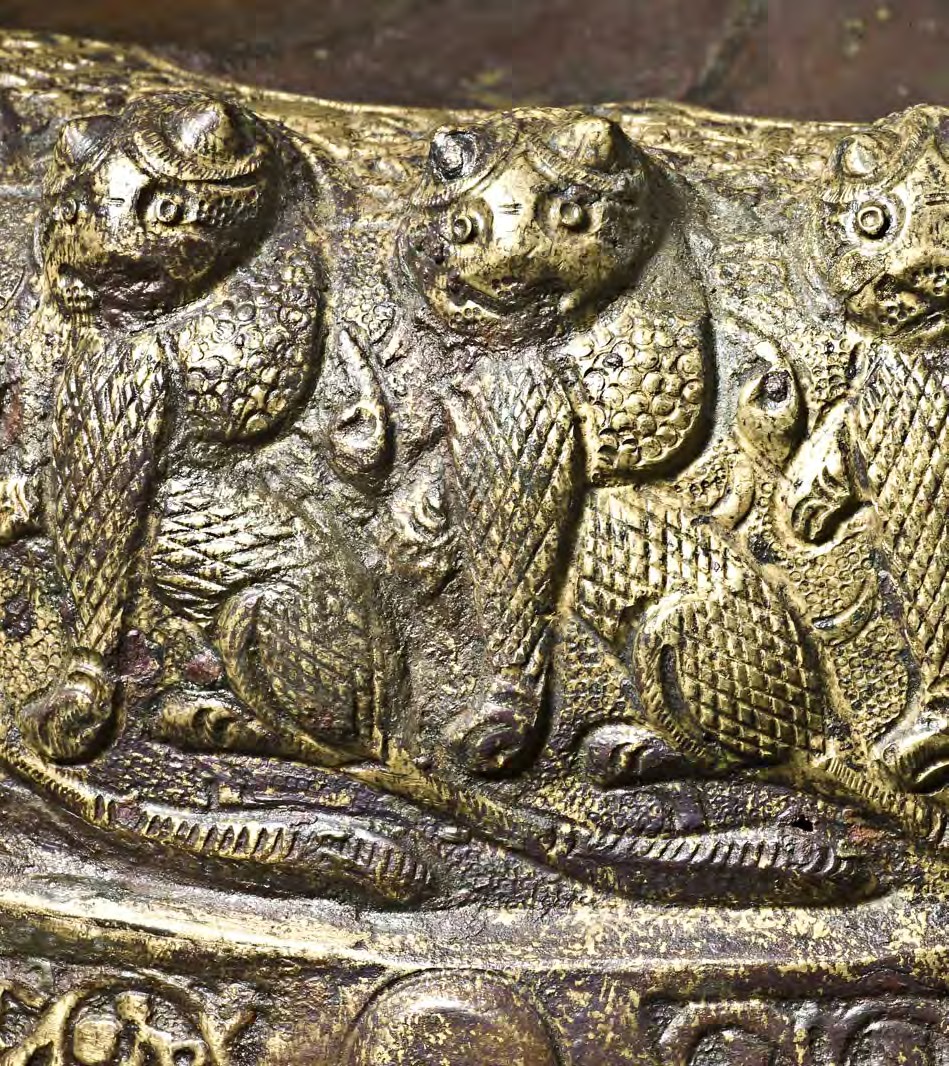 | |||
| Khurasan (northeastern I ran/Afghani stan), possi bl y Herat; l ate twel fth or thi rteenth centur y Chased and beaten brass Hei ght: 35 cm; di ameter: 46. 5 cm AKM 884 Unpubl i shed |
This piece is one of a small group of repoussé candlesticks
thought to come from late twelfth- or thirteenth-century
Khurasan (an area roughly comprising northeastern Iran
and Afghanistan), and quite possibly linked to production
at Herat.
The repoussé technique involves beating shapes into sheet metal from the reverse side, and is normally practiced in conjunction with chasing, by which the design is refined on the front side with further beating and engraving, using punches and sharp tools.
Through such means the artist has here exploited the plasticity of brass, creating a complex design of lions in high relief at top and bottom, with a central frieze of plain hexagonal bosses belted in by two thin bands of scrolling vegetal arabesque panels and round studded knobs.
The lions’ heads project boldly from the candlestick, while their bodies are in much lower relief, sitting up in tight formation around the object. The refinement of the repoussé technique was one of the singular artistic achievements of the period, and in the right hands it could elevate brass to the status of a luxury medium.
A repoussé and inlay ewer in the Georgian National Museum, Tbilisi – one of a group of fine vessels of this type – bears an inscription that names Herat as the site of its production, and it is possible that the present candlestick may also be of Herat manufacture.
A further example in the David Collection, without
inlay,
may be more closely compared with this piece,
although like the inlaid examples it also has chased decoration
on
each
of
the
hexagonal
bosses,
distinguishing
it
from
the
present
example.
Another related example, without any repoussé animals,
was photographed in the Pars Museum, Shiraz. The Aga Khan Museum’s can-
dlestick has a slightly more flared outline than the other
known examples of this form.
The enormous religious significance of light meant
that commissioning light fittings, including candlesticks,
for mosques, tombs and shrines was a sacred act in the
medieval period and indeed later .
The mystical dimensions of the candle as a pious object are exemplified in a poem in the twelfth-century Diwan of Khaqani, composed on the occasion of a princess’ return from pilgrimage to Mecca and Medina: ‘Your eye like a candle shed the tears of necessity/ And from so much light in it/ the Prophet’s mausoleum turned into a candlestick’ .
It is also possible that the presence of lions – an ancient symbol of the sun – on these repoussé candlesticks is intended to add a further layer of light symbolism to the light fitting.
Book Reference :
Architecture in Islamic Arts Treasures of the Aga Khan Museum by Margaret S. Graves, Benoît Junod, Gérard Friedli
https://www.academia.edu/7471091/Treasures_of_the_Aga_Khan_Museum_Architecture_in_Islamic_arts













0 comments:
Post a Comment